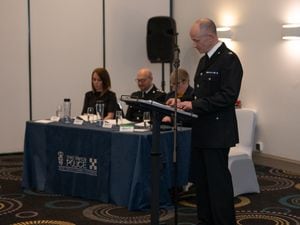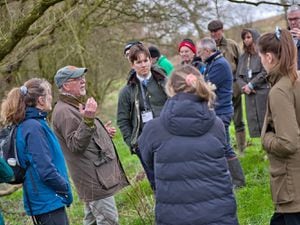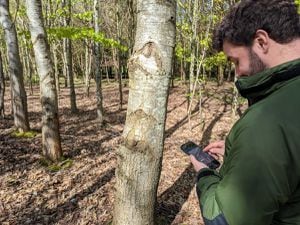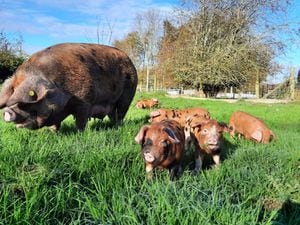Kim Hughes - Shropshire's George Cross holder
Shropshire soldier Staff Sergeant Kim Hughes is a hero - the bravest of the brave. In March the Telford-based soldier was awarded the George Cross for gallantry. Today, the Shropshire Star exclusively publishes the extract of Kim Hughes's story.
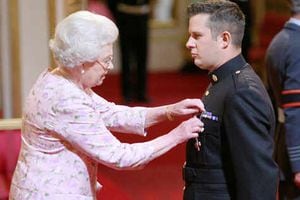
Shropshire soldier Staff Sergeant Kim Hughes is a hero - the bravest of the brave.
During his deployment in Afghanistan he risked his own life to save the lives of his comrades, foregoing protective clothing and defusing bombs manually in what has been described as the single most outstanding act of explosive ordnance disposal ever recorded in Afghanistan.
In March the Telford-based soldier was awarded the George Cross for gallantry.
Mr Hughes's incredible tale is told in a new book, George Cross Heroes by Michael Ashcroft, published by Headline Review on November 11.
Today, the Shropshire Star exclusively publishes the extract of Kim Hughes's story.
Kim Hughes was born in Munster, Germany, on 12 September 1979.
He was the middle one of three children and the son of an Army serviceman who was a staff sergeant in the Royal Electrical and Mechanical Engineers.
As a boy, Hughes was brought up in Weston-super-Mare, Somerset, and, later, Telford, Shropshire.
He attended William Reynolds Junior School and Thomas Telford School for his secondary education, both in the Shropshire town.
He left school at 16 to join the Royal Logistic Corps but was initially unsettled in the Army and quit after less than a year.
However, he quickly decided that Civvy Street was not for him and, after a year doing manual work, rejoined the Army at eighteen — and never looked back.
He was a private working as an RLC driver for three years, before training to be a driver with a bomb disposal team.
However, he then successfully applied to become an ammunition technician, training for three years and being promoted to lance corporal. He subsequently served three tours in Northern Ireland, two in Bosnia, one in Iraq and one in Afghanistan.
Tasked
Hughes went to Helmand Province, Afghanistan, in April 2009 as a staff sergeant working as a high-threat improvised explosive device disposal operator.
He took part in Operation Panther's Claw and worked closely with the Danish Battle Group. By August, Hughes was working alongside the Royal Engineers' Search Team and was tasked with providing close support to 2 Rifles Battle Group during an operation to clear a route south-west of Sangin.
As part of the preparations for the operation on August 16, 2009, a part of A Company was deployed early to secure an emergency helicopter landing site and to isolate enemy compounds to the south of the route. During these preparations, a serviceman initiated a victim operated improvised explosive device and was seriously wounded.
As the casualty was being recovered, one of the stretcher-bearers initiated a second VOIED which resulted in two people being killed outright and four others being very seriously injured (one of whom later died from his wounds).
It thus became abundantly clear that the area was effectively an IED minefield being overwatched by the enemy.
Injured
Staff Sergeant Hughes and his team were called to what the Army described as a 'harrowing and chaotic situation'. Their task was to recover both casualties and bodies, and they knew speed was of the essence if further lives were not to be lost.
To save time, Hughes did not wait to put on protective clothing. Instead, he immediately set about clearing a path to the injured servicemen, while providing constant reassurance that help was on its way.
When Hughes reached the first injured soldier, he discovered another VOIED within a metre of the casualty. This threatened the lives of all the casualties and, of course, Hughes himself.
Hughes did not know the power source of the IED but he knew full well that the servicemen needed urgent medical help so he carried out a "manual neutralisation" of the device knowing that any error would be instantly fatal.
He had, in effect, carried out a 'Category A' action where not taking action is almost certain to result in further casualties and the emphasis is on saving other people's lives, if necessary, at the expense of the operator. Hughes had, by any standards, been responsible for an exceptional act of gallantry. With shots now keeping the enemy at bay, Hughes calmly turned his attention to the remaining casualties and to retrieving the dead: servicemen will never knowingly leave the bodies of comrades.
As he cleared a path, Hughes discovered two further VOIEDs. Twice more, he carried out exceptionally risky "manual neutralisations".
By this selfless action, he enabled all the casualties to be extracted and the bodies recovered. Yet even this was not the end of Hughes's courage.
The REST had detected a further four VOIEDs in the immediate vicinity. Hughes set about disposing of them too - just as he had done to more than eighty similar devices over the previous five months of his tour of duty.
His George Cross was announced on 18 March 2010 - one day ahead of when it was formally published in the London Gazette - when the citation ended: "Dealing with any form of IED is dangerous; to deal with seven VOIEDs linked in a single circuit, in a mass casualty scenario, using manual neutralisation techniques once, never mind three times, is the single most outstanding act of explosive ordnance disposal ever recorded in Afghanistan.
That he did it without the security of specialist protective clothing serves even more to demonstrate his outstanding gallantry.
"Hughes is unequivocally deserving of the highest level of public recognition."
After the news of his GC and his courage was made public, Hughes said that the thought of being killed had not entered his head.
"You are always thinking one step ahead. Thinking you are going to die doesn't cross your mind. You just crack on and get on with it."
Hazardous
Colonel Stuart Archer and Major Pete Norton, both awarded the GC for equally hazardous bomb disposal work, were present when the Ministry of Defence announced the award for Hughes and the posthumous award for Staff Sergeant Olaf 'Oz' Schmid.
Hughes's father, Barry, and four comrades joined him for the 'awesome' day of the GC announcement.
Hughes received his decoration from the Queen at an investiture at Buckingham Palace in June. After the ceremony, he said of his GC: "When you do your training, you don't think you'll get recognition like this. We're just out there doing our job: to get this is outstanding.
"I accept it on behalf of all the other operators in Afghanistan."
His mother, Frances, brother, Sergeant Lee Hughes, and sister-in-law, Emma Hughes, joined him at the investiture.
In an interview at Marlborough Barracks in Warwickshire, Hughes disclosed to me that on his last day 'on the ground', before the incident for which he was primarily awarded the GC, he had been injured in an explosion working with the Danish Battle Group.
On that occasion, prior to his rest and recuperation (R&R) back in the UK, a VOIED had initiated directly under
Hughes as he sat in an armoured personnel carrier. He was knocked unconscious, injured his leg, had a perforated eardrum and suffered concussion, the latter resulting in his R&R being brought forward after he was 'casevaced' in a US Black Hawk helicopter to Camp Bastion.
His first day back 'on the ground' after R&R was when his eleven-man team came across the terrible scenes of dead and injured servicemen on 16 August 2009 near Sangin.
Explosion
"I just had my body armour and helmet on. Straight away I could see a fallen soldier who was dead. Then I could see the carnage - bodies and soldiers all over the place and a young female medic was screaming.
"When there is a 'Category A' situation - a grave and immediate threat to life - you just have to get on with it. "There wasn't the time to get a bomb suit on or send a robot down the road. The priority was to get the casualties out.
"I was faced with a device and I had to make an assessment of how it worked. I was able to uncover parts of the device to see the key components and then make them safe.
Beauty
"The search team then found another two devices and I found another two, so I dealt with seven in all.
The whole task was completed in about forty-five minutes. Eventually, we learnt that all seven devices were linked to one circuit, which we hadn't seen before."
Hughes said that the Taliban tactic of using IEDs is hard to combat.
"We are fighting an enemy we can't see. When we move on from an area, they move back in and place IEDs but that is the nature of the beast over there.
"The part that keeps me going is that I am achieving something by helping the Battle Group and the troops out on the ground.
"To see the faces of the troops when you rock up is great - it's like the cavalry has arrived. They are very appreciative of what we do.
"We are all very, very close and so it's hard to lose mates - people who feel like family. It's horrendous really."
Hughes has a son Jack, aged four, from a previous relationship, while his girlfriend, Corporal Kelly O'Connor, also works for the RLC as a driver with a bomb disposal team. Hughes is currently training high-threat IEDD operators.
Aged 31, he expects to serve at least another two six-month tours in Afghanistan over the next four years. Hughes, who was promoted to warrant officer class 2 in the summer of 2010, admitted that this prospect is a formidable challenge.
He said: "It's tough out there - it's a war zone. But it's my job: that's what I am paid to do.'
George Cross Heroes by Michael Ashcroft is published by Headline Review on November 11.

